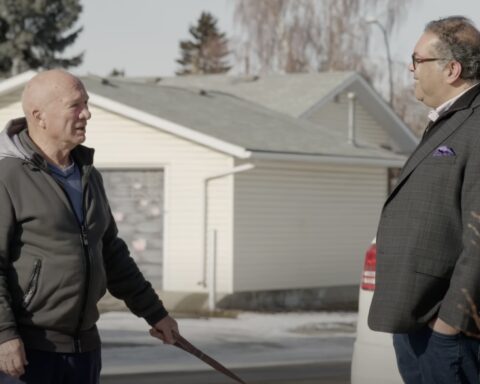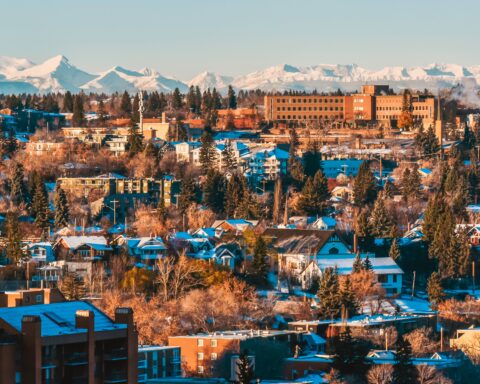The roots of Canada’s political culture can be traced through the history of its immigration patterns.
In his classic analysis of the Founding of New Societies, Louis Hartz demonstrated how the political cultures of new countries founded by Europeans were impacted most by the initial formative waves of immigration.
Gad Horowitz’s application of Hartz’s thesis to Canada took note of the foundational influence the Loyalist wave of immigrants had. When that culture combined with the more collectivist, quasi-feudal political culture of the early French inhabitants, it produced a liberal-pluralist political culture that is marginally more accepting of collectivist public endeavours than is the nearly pure liberal political culture of the United States. In Canada, a primarily liberal, pluralist, democratic political culture took root and corresponding political and legal institutions were established.
Newcomers are encouraged to freely and openly exercise their democratic liberties.
Subsequent waves of newcomers, and in particular their offspring, tend to integrate into that broader liberal-pluralist-democratic political culture (I’d say assimilate, but that has unseemly American connotations for most Canadians).
Newcomers are encouraged to freely and openly exercise their democratic liberties while also encouraged to freely and openly participate in distinct ethnic, linguistic, religious and economic subcultures within the pluralist milieu that is Canadian multiculturalism.
Indeed, although not without its legitimate critics, Canadian multiculturalism is a political culture success story. Evidence abounds demonstrating that Canada has experienced much less ethnic, religious and linguistic strife than many countries that derive far lower percentages of their total populations from immigration.
Historical Context
As Canada expanded westward, the new societies that were established on the prairies were essentially internal colonies of the Dominion and therefore the liberal-pluralist-democratic political culture was transported here from the centre. But the first three early waves of immigrants that filled the prairie west in the late 19th and early 20th centuries marginally altered the political culture of each new prairie province, giving each a slightly distinct character.
Nelson Wiseman applied the Hartz-Horowitz thesis to the pattern of early prairie settlement. He observed that the first wave of immigrants, dominated by rural Ontarians, settled primarily in southern Manitoba, and established a political culture that was a prairie reflection of their home province.
[In the late 19th and early 20th centuries] the third wave [of immigrants] settled in Alberta and was dominated by Midwestern Americans who brought with them a somewhat greater appreciation for democratic populism.
The second wave of immigrants settled in southern Saskatchewan and was dominated by British settlers coming from the United Kingdom at a time when labourism had become a force within that country. Hence, the Saskatchewan political culture, essentially liberal-pluralist-democratic at its core, adopted a marginally greater tolerance for collectivist public policy experiments.
The third wave settled in Alberta and was dominated by Midwestern Americans who brought with them a somewhat greater appreciation for democratic populism. Hence, my home province’s slightly greater propensity to repeatedly spawn seemingly spontaneous (at least when viewed from the outside) outbursts of political housecleaning, the likes of which we witnessed in the most recent provincial election.
A few examples of how abrupt the changes can be include the ascendency of the recently dispatched Progressive Conservative (PC) regime, having itself moved from six seats to majority government when it dislodged the 35-year Social Credit dynasty in 1971. In 1935, the Socreds, a new party itself, toppled the long governing United Farmers of Alberta who, as a new party in 1921 ousted the long-serving Liberals.
This populist political behaviour is not limited to provincial politics. In 1921, Alberta voters also embraced the Progressive charge that dislodged both established federal parties from the prairies. In 1935, Albertans turned to the federal Socreds rather than either traditional party when the Progressives had run their course. More recently, in 1993, Reform swept away the federal PCs who had been dominating Alberta since John Diefenbaker led them to victory in 1958.
Instructive for the Hartz-Horowitz thesis is what happens to subsequent waves of immigrants who arrive after the founding political culture has been established.
An initial cursory survey of the election results in ridings where immigrant populations are large makes it appear as though immigrant-heavy ridings followed the provincial and regional trends with no greater or less propensity.
By and large, subsequent waves of immigrants tend to integrate into the more broadly based political culture, as did the fourth wave of central and northern European immigrants who arrived in all three prairie provinces early in the 20th century, but after the provincial political sub-cultures had congealed.
Hence, here in Alberta, we have no reason to suspect that newcomers were any more or less likely to have participated in, or significantly altered one way or the other, this most recent populist eruption.
The Alberta Way
As the election results and emerging post-election survey data appear to be making clear, the 2015 revolt against the old PC regime that swung more in favour of the New Democratic Party (NDP) than Wildrose was very widespread and certainly not limited to, or dominated by, any particular demographic group.
An initial cursory survey of the election results in ridings where immigrant populations are large, particularly in central and northeast Calgary, makes it appear as though immigrant-heavy ridings followed the provincial and regional trends with no greater or less propensity, given allowances for other variables.
What surprises most outsiders, and hence their tendency to want to pin the blame (or credit, as the case may be) on one group or another, is the swift and thoroughness of the change, and the fact that it was accomplished by a centre-left coalition rather than a centre-right coalition.
When trust is broken, as it surely was by the provincial PCs over the past several years, we abruptly, in one election, dismember that entrenched, majority dynastic government and entrust majority government power to a formerly minor, sometimes completely new, party.
The swiftness and thoroughness can be attributed to the way we do things here in populist-prone Alberta: stick with a political party for decades, allowing it to thoroughly dominate the electoral political space until it is long past its prime.
When trust is broken, as it surely was by the provincial PCs over the past several years, we abruptly, in one election, dismember that entrenched, majority dynastic government and entrust majority government power to a formerly minor, sometimes completely new, party.
The fact that a progressive coalition united under the capable leadership of the NDP campaign and succeeded in dislodging the PCs in 2015 shouldn’t be that much of a surprise given that it was an albeit unstable and hastily cobbled together progressive coalition led by then PC premier, Alison Redford, that beat back the Wildrose threat in 2012.
This is part two of a three-part commentary series examining what happened during the 2015 Alberta elections. Next up, we will take a comprehensive look ahead at what the provincial election results may mean in October’s federal election.
Faron Ellis teaches political science and history in the School of Liberal Arts at Lethbridge College and is principal investigator at the Citizen Society Research Lab. He has published various books, academic articles and op-eds about Canadian and Alberta politics and served as a Lethbridge city councillor.





